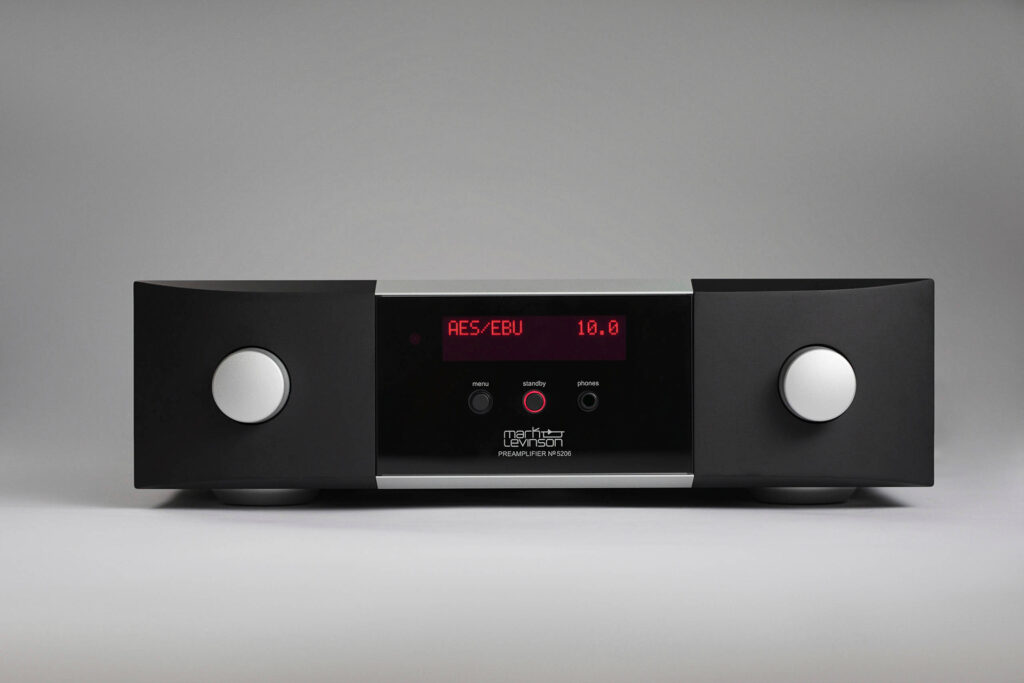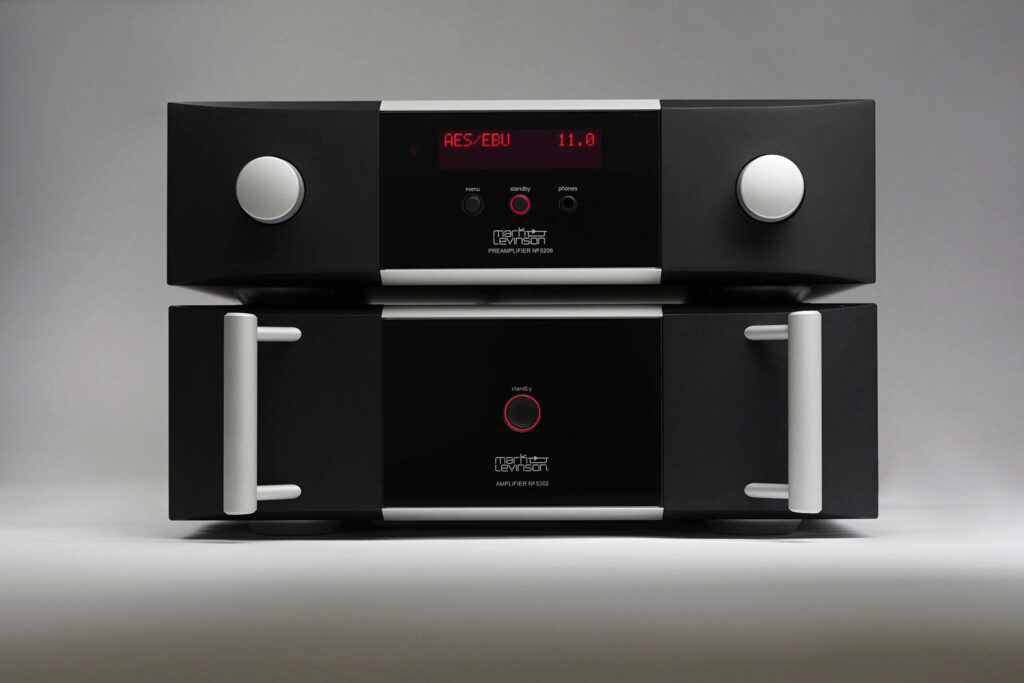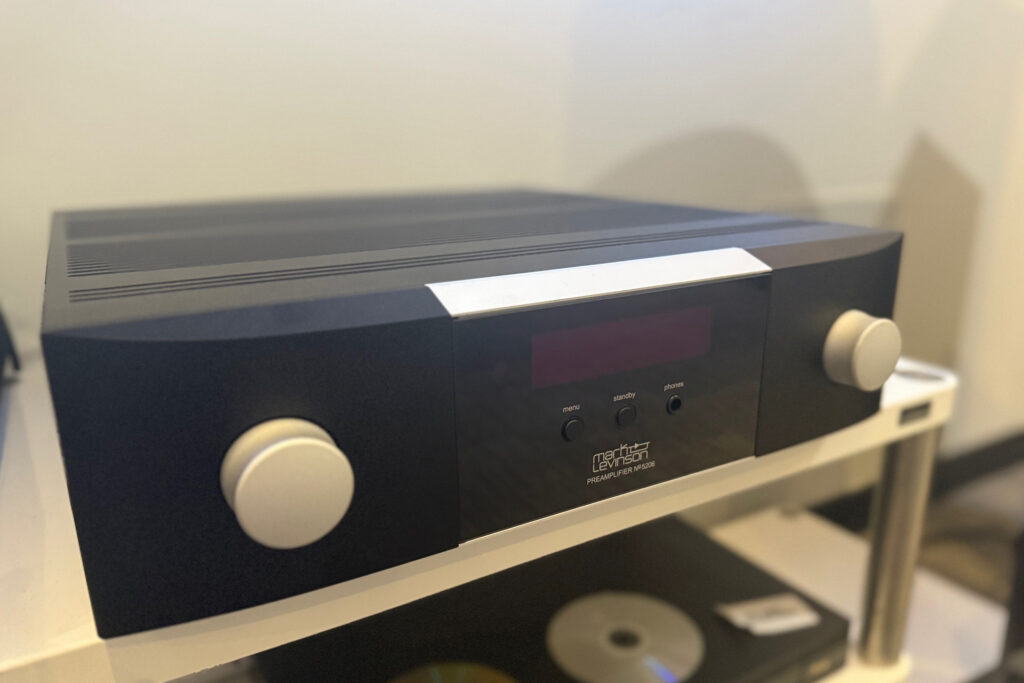One of the most transformational products ever launched during my audiophile career was the Mark Levinson No. 38 stereo preamp. It was released soon after I went to work for Christopher Hansen Ltd. in Beverly Hills back in 1993, and this audiophile component simply changed the game from Day One. At the time, there was no more respected audiophile brand of electronics in the world than Madrigal’s (Harman didn’t own them yet) Mark Levinson and the No. 38 stereo preamp was their first remote-controlled offering. With a thick aluminum, non-backlit remote and a smooth-feeling volume control, this preamp made its way into many of our clients’ systems, with each and every one of them raving about the $4,000 investment.
Today, Mark Levinson has evolved their preamp offerings quite a bit, but they still have roughly the same basic DNA. The $11,000 Mark Levinson No. 5206 preamp is a perfect example of such evolved design. Besides performance tweaks, the biggest difference between the Mark Levinson No. 5206 and those legendary preamps of the brand’s past is that the No. 5206 has a slick internal DAC. That’s not all this audiophile input switcher and volume adjuster does, but what it doesn’t do is a more important topic. Its design goal is to not impart a sound upon your sound. While some audiophiles still like to mix and match colored-sounding components, that is not why somebody invests $11,000 in a Mark Levinson No. 5206. How does this preamp hang in today’s market? That’s what we are here to explore.

What Makes the Mark Levinson No. 5206 Preamp So Special?
- The internal DAC is a 32-bit design that uses Mark Levinson’s Precision Link II design. It is an ESS chipset and is fully balanced. It can be connected in any number of ways, including AES-EBU, S/PIDIF, COAX, and USB. It supports MQA if you care (I don’t, but it is worth a mention).
- You can connect a Mark Levinson No. 5206 via Bluetooth if you are so inclined. While Bluetooth is not a really a premium audiophile connection in most instances, it sure as hell is useful and mindful of how the modern audiophile might want to enjoy their stereo preamp.
- The build quality of the Mark Levinson No. 5206 is simply tiptop and it is made in the United States. Everything just feels right about using this preamp. Plugging the cables in the back, spinning the volume control, switching the inputs – it all just exudes engineering excellence, as well as luxury. The fact that the products are protected from the whims of an unstable president and his ignorant tariffs are a plus to anyone on either side of the aisle.
- The Mark Levinson No. 5206 includes a MM or MC phonostage internally. While not for other inputs, the phono input can use RIAA EQ curves designed for such a legacy format and its specific issues. Removing the need for an external phonostage adds value to an expensive audiophile component, and we like that.
- While Mark Levinson makes my favorite/reference wireless headphones, which you can connect to a Mark Levinson No. 5206, the preamp also has a very capable headphone option. I didn’t have any hard-to-drive wired headphones to test, but reportedly the No. 5206 is able to handle even then trickiest and/or most exotic headphones.
- There are four analog inputs included, along with even more digital (and phono) options.That’s a pretty fair number of components that you can connect to a Mark Levinson No. 5206 preamp.
- For audiophiles like me, who also own home theaters and more specifically a Crestron home automation system, having options like RS-232, IR and 12-volt is really helpful.
- The signal path for the Mark Levinson No. 5206 is dual mono, balanced and fully discrete.The website boasts that Harman has two patents on their technologies, which is always impressive.

Why Should You Care About the Mark Levinson No. 5206 Stereo Preamp?
The audiophile who is likely to be shopping for a Mark Levinson No. 5206 is not buying his or her first stereo preamp. At this stage in your audiophile journey, you are looking for excellence, simplicity and function. There are simpler preamps in this price category, as well as far more complex ones. The Mark Levinson No. 5206 strikes a blue-chip balance on this front. Also, the Mark Levinson No. 5206 sonically appeals to the people who aren’t looking for their preamp to bring its own sonic agenda to your system. The Mark Levinson No. 5206 is designed to be sonically neutral, which is a sought-after design goal for most audiophiles. Not all of us can afford to get there, but it is a good aspiration nonetheless.
Some Things You Might Not Like About the Mark Levinson No. 5206 Preamp
- The DAC is built into the Mark Levinson No. 5206 and that limits your ability to upgrade down the road. The Mark Levinson No. 5206 has the ability to do software updates, but you aren’t going to be swapping out DAC chipsets or other integrated technologies. If you wanted a better DAC than the one that comes inside of the Mark Levinson No. 5206, you can add such a component (same argument can be made with the phonostage) if you like. The problem is that you can’t really use the audiophile equity that you have in your Mark Levinson No. 5206 to incrementally upgrade, the way an audiophile can when they keep their components fully separate.
- The signature red lights can be piercing when listening in a dark room. You can dim the lights, which is good, but the Mark Levinson No. 5206 still has a physical presence in your room. Does this change the sound? Nope. This is a small gripe.
- The remote on the Mark Levinson No. 5206 is still clunky, like the ones that we had back in the day. I greatly prefer to use my handheld Crestron remote and, with a little paid programming, this is possible. However, in reality, I can control volume and switch music using my Bluesound Node ICON (read the review) right from my iPad, which is a piece of cake and requires no expensive programming. That is even easier.
Listening to the Mark Levinson No. 5206 Preamp …
To evaluate the Mark Levinson No. 5206, I had to use an alternative listening room that included some very familiar gear, such as the aforementioned Bluesound Node ICON music streamer (with Qobuz as an HD streaming source), a Mark Levinson 5302 amp (read the review), and my reference Bowers & Wilkins 802 D4 speakers.
On the bossa nova-influenced classic “You’ll Never Find” from Lou Rawls, I was able to experience the rich layering and depth that I love to hear from multi-track recordings. While this is a legacy or historical recording from the 1970s, the strings made famous by Philadelphia producers (in this case songwriters) Kenny Gamble and Leon Huff sounded lush and engaging. You could hear the subtle vibrato, but they were never out of place. Rawl’s voice is rich and deep, but the piano tone was most striking to me when you listen to the first verse. There was a round, alive, three-dimensional sound that was more like an instrument than a stereo. The Mark Levinson No. 5206 didn’t bring a sonic agenda to the conversation as much as it delivered you a window onto a musical world that felt more like what the song was supposed to sound like.

“Hey Nineteen” by Steely Dan is the most Yacht Rock song of what is likely the most Yacht Rock band in musical history. Written by Boz Skaggs, Donald Fagen and the ubiquitous Michael McDonald, this track is a bit skeezy by today’s standards, but when have I ever shied away from a tasty demo track like this? I don’t drink anymore, but I will say that Cuervo Gold is pure poison and, if you have the money for a Mark Levinson preamp, you have enough money to buy yourself non-poisonous tequila. Rant over. We all know this song, so when I suggest that the layering and depth of the vocals in the first chorus is nothing short of mesmerizing, I am not joking. The Walter Becker guitar chords have more depth in the mix than I’ve heard in other stereo preamps at this level. The overall coherence of this time-tested and guilty pleasure song is worthy of a spin if you are considering such a preamp, and I don’t care how old you are, as Steely Dan in 2025 has as much appeal to youthful audiophiles as it does to the audiophiles who bought the record when it came out new in the stores back in 1980.
If you don’t love a song that starts with the chorus, then I don’t know how to help you. “Living After Midnight” from Judas Priest is a jam that we used to play in my music school (God-awful) cover band named Ghetto Chicken. The song is beyond simplistic, but it did show off some of the musical details that I could hear that aren’t easily heard on other, lesser stereo preamps. Listen to the somewhat “dry” sound (dry refers to reverb and not much is used here) on the snare drum as the song starts its heavy metal assault on your sonic senses. Rob Halford’s voice has a vivid yet gravelly sound that made me play this track a few times in a row just to enjoy.
I didn’t have a suitable audiophile turntable to test the phonostage but, if I did, I would want to use the Mark Levinson No. 5105, which is made by another made-in-America brand for Mark Levinson, VPI. Clearaudio from Germany makes McIntosh’s MT5 turntable (read Paul Wilson’s review), as most audiophile electronics companies don’t have the ability to cook up a good audiophile turntable, so they have another, more expert company make one via OEM.
Will the Mark Levinson No. 5206 Hold Its Value?
Mark Levinson is one of the most respected lines of audiophile components in the world. Generations of audiophiles have been dreaming of owning Mark Levinson gear since the late 1970s, when Levinson was running the company from Connecticut before losing control of his namesake corporation in 1982 en route to starting his next brand, Cello, where I would work with Levinson himself.
Mark Levinson gear holds its value very well over time, and a feature-laden preamp like this, with all sorts of modern technological goodies like a headphone jack/amp, a phonostage, a modern 32-bit DAC and control options, makes for a desirable product. Being sold in Magnolia AV stores now helps, too. Brand awareness from the Lexus automotive deal supports good resale value. A good portion of your $11,000 will be somewhat well-protected for years if you invest in such a lofty stereo preamp.

What is the Competition for the Mark Levinson No. 5206 Preamp?
The Wayne Colburn-designed Pass Labs XP-22 (read my review) at $9,999 comes to mind. I just cut the check for the three-chassis Pass Labs XP-32 (read Jim Swantko’s review) that is $22,000 retail, and that Swantko was able to do The Pepsi Challenge on with an XP-22. One thing Swantko and I agree on is that we love the Pass XP-22. Swantko and I have both owned a number of Mark Levinson stereo preamps in our day, too. The Pass Labs XP-22 has no included DAC. It has no phonostage, either. It has no headphone amp. It has a dicey remote and no Bluetooth. What it does have is that Nth degree of resolution on your music that someone who is shopping for a world-class $10,000-plus preamp will demand. Does the Mark Levinson No. 5206 deliver on the same resolution? It sure does, but they sound a little bit different, and the fun of the hobby at this lofty level is picking the exact level of awesome that you want because, friends, you can’t lose in this audiophile pick ’em.
Last year, I was able to spend some time with the Boulder 812 DAC/Preamp (read my review)which is priced around $9,300. Like the Mark Levinson No. 5206, the Boulder is a resolved audiophile preamp with a very capable internal DAC. The metalwork, as I learned when I toured the Boulder factory two years ago, is beyond amazing. The Boulder 812 is another made-in-America audiophile product that doesn’t have to worry about tariff-based price increases. I don’t like the smaller form factor of the Boulder 812. It also doesn’t have as many features as the Mark Levinson No. 5206, such as an internal phonostage.
Paul McGowan, the audiophile engineer behind PS Audio, just came out with a signature line of electronics under the PS Audio PMG moniker. Swantko owns a $50,000-plus CH Precision stereo preamp and he cannot stop raving about the PS Audio PMG Signature Preamp (read his review here). That is some very high praise and, in this competitive matrix, McGowan’s PS Audio preamp is the least expensive comp. It is missing an internal DAC but, as I found out last year, the PS Audio Stellar Gold DAC (read my review) is a very solid player and benefits from having its own very solid power supply. For myself, I like having upgrade options on each of my audiophile components. Others like the all-in-one chassis level of simplicity when it comes to an audiophile preamp. I am not sure that you can make a bad decision when it comes to either direction.

Final Thoughts on the Mark Levinson No. 5206 Stereo Preamp …
Everybody in the audiophile world kisses McIntosh’s ring for being a design legend. McIntosh is a lot like the “audiophile Harley Davidson” and, without question, they are iconic in terms of brand, for their sound as well as their industrial design. I’ve been fortunate enough to review lots of their best gear recently. If you were going to run with this motorcycle analogy, what if you were looking something more in the Ducati world? That’s where the Mark Levinson No. 5206 comes in.
Is the Mark Levinson No. 5206 legendary or iconic? Yes sir, it is. It also is a colorless audiophile preamp that is packed with today’s best features and patented technologies in the preamp’s topography. It includes an internal DAC that is really strong in terms of its performance, while also including a very well-designed phonostage and options for connecting your wired audiophile headphones.
There’s little the Mark Levinson No. 5206 doesn’t do as an audiophile preamplifier. At $11,000, the Mark Levinson No. 5206 isn’t anywhere close to entry-level in terms of price. It is more in the category of “the last preamp you might ever need” in terms of its market presence. That makes the investment in a Mark Levinson No. 5206 much easier to say yes to, as this is one hell of a good audiophile stereo preamp.




How’s about sticking to an Audio component reveiw, and leave the political comments out of it.
Bigly.
Cofeffe